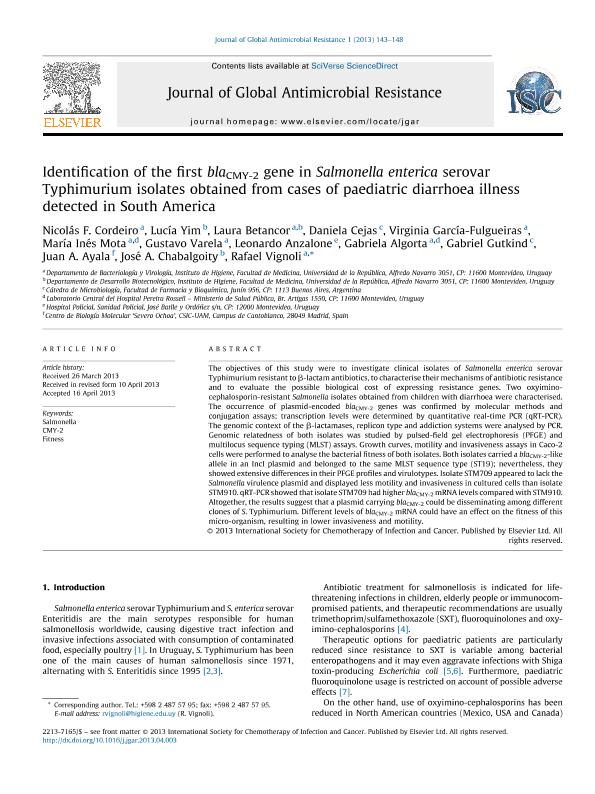Artículo
Identification of the first blaCMY-2 gene in Salmonella enterica serovar Typhimurium isolates obtained from cases of paediatric diarrhoea illness detected in South America
Cordeiro, Nicolás F.; Yim, Lucía; Betancor, Laura; Cejas, Daniela ; García Fulgueiras, Virginia; Mota, María Inés; Varela, Gustavo; Anzalone, Leonardo; Algorta, Gabriela; Gutkind, Gabriel Osvaldo
; García Fulgueiras, Virginia; Mota, María Inés; Varela, Gustavo; Anzalone, Leonardo; Algorta, Gabriela; Gutkind, Gabriel Osvaldo ; Ayala, Juan A.; Chabalgoity, José A.; Vignoli, Rafael
; Ayala, Juan A.; Chabalgoity, José A.; Vignoli, Rafael
 ; García Fulgueiras, Virginia; Mota, María Inés; Varela, Gustavo; Anzalone, Leonardo; Algorta, Gabriela; Gutkind, Gabriel Osvaldo
; García Fulgueiras, Virginia; Mota, María Inés; Varela, Gustavo; Anzalone, Leonardo; Algorta, Gabriela; Gutkind, Gabriel Osvaldo ; Ayala, Juan A.; Chabalgoity, José A.; Vignoli, Rafael
; Ayala, Juan A.; Chabalgoity, José A.; Vignoli, Rafael
Fecha de publicación:
05/2013
Editorial:
Elsevier
Revista:
Journal of Global Antimicrobial Resistance
ISSN:
2213-7165
Idioma:
Inglés
Tipo de recurso:
Artículo publicado
Clasificación temática:
Resumen
The objectives of this study were to investigate clinical isolates of Salmonella enterica serovar Typhimurium resistant to β-lactam antibiotics, to characterise their mechanisms of antibiotic resistance and to evaluate the possible biological cost of expressing resistance genes. Two oxyimino-cephalosporin-resistant Salmonella isolates obtained from children with diarrhoea were characterised. The occurrence of plasmid-encoded blaCMY-2 genes was confirmed by molecular methods and conjugation assays; transcription levels were determined by quantitative real-time PCR (qRT-PCR). The genomic context of the β-lactamases, replicon type and addiction systems were analysed by PCR. Genomic relatedness of both isolates was studied by pulsed-field gel electrophoresis (PFGE) and multilocus sequence typing (MLST) assays. Growth curves, motility and invasiveness assays in Caco-2 cells were performed to analyse the bacterial fitness of both isolates. Both isolates carried a blaCMY-2-like allele in an IncI plasmid and belonged to the same MLST sequence type (ST19); nevertheless, they showed extensive differences in their PFGE profiles and virulotypes. Isolate STM709 appeared to lack the Salmonella virulence plasmid and displayed less motility and invasiveness in cultured cells than isolate STM910. qRT-PCR showed that isolate STM709 had higher blaCMY-2 mRNA levels compared with STM910. Altogether, the results suggest that a plasmid carrying blaCMY-2 could be disseminating among different clones of S. Typhimurium. Different levels of blaCMY-2 mRNA could have an effect on the fitness of this micro-organism, resulting in lower invasiveness and motility.
Palabras clave:
Salmonella
,
Cmy 2
,
Fitness
Archivos asociados
Licencia
Identificadores
Colecciones
Articulos(OCA HOUSSAY)
Articulos de OFICINA DE COORDINACION ADMINISTRATIVA HOUSSAY
Articulos de OFICINA DE COORDINACION ADMINISTRATIVA HOUSSAY
Citación
Cordeiro, Nicolás F.; Yim, Lucía; Betancor, Laura; Cejas, Daniela; García Fulgueiras, Virginia; et al.; Identification of the first blaCMY-2 gene in Salmonella enterica serovar Typhimurium isolates obtained from cases of paediatric diarrhoea illness detected in South America; Elsevier; Journal of Global Antimicrobial Resistance; 1; 3; 5-2013; 143-148
Compartir
Altmétricas



